Cultivating healthy indoor plants depends on providing them with the right balance of essential nutrients. A study by the American Society for Horticultural Science reveals that indoor plants can remove up to 87% of air toxins in just 24 hours, demonstrating their immense value in improving air quality and overall well-being. However, maintaining optimal soil nutrient levels can be challenging for indoor gardeners, as various factors influence nutrient availability and uptake.
In this comprehensive guide, we’ll delve into the intricacies of testing and adjusting soil nutrient levels for indoor plants, covering the key nutrients, soil testing methods, pH adjustments, addressing deficiencies, and maintaining optimal conditions. Drawing from scientific research and expert insights, we aim to provide you with the ultimate resource for creating a thriving indoor garden.
What are the key soil nutrients for indoor plants?
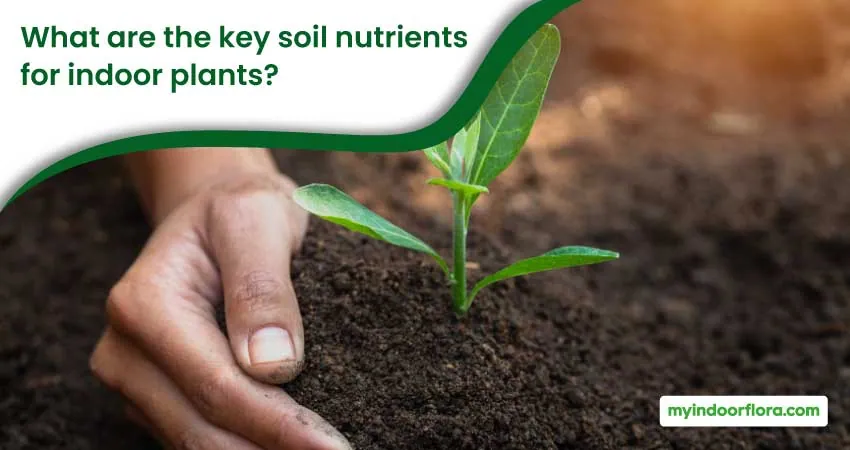
Plants require a mix of nutrients to maintain good health and growth. These nutrients are divided into three categories: primary, secondary, and micronutrients.
Primary nutrients: Nitrogen (N), Phosphorus (P), and Potassium (K)
These are the nutrients plants need in the largest quantities. Nitrogen promotes foliage growth, while phosphorus supports root development and flowering. Potassium ensures overall plant health by regulating various physiological processes.
Secondary nutrients: Calcium (Ca), Magnesium (Mg), and Sulfur (S)
Although needed in smaller quantities than primary nutrients, secondary nutrients are still essential for plant growth. Calcium aids in cell wall development, magnesium is a vital component of chlorophyll, and sulfur plays a crucial role in protein synthesis.
Micronutrients: Iron (Fe), Manganese (Mn), Boron (B), Copper (Cu), Zinc (Zn), Molybdenum (Mo), and Chlorine (Cl)
Micronutrients are needed in trace amounts, but they’re still essential for plant health. They support various enzymatic and metabolic processes, ensuring proper growth and development.
With a clear understanding of the essential nutrients, let’s move on to testing and analyzing the soil.
How to test soil nutrient levels for indoor plants?
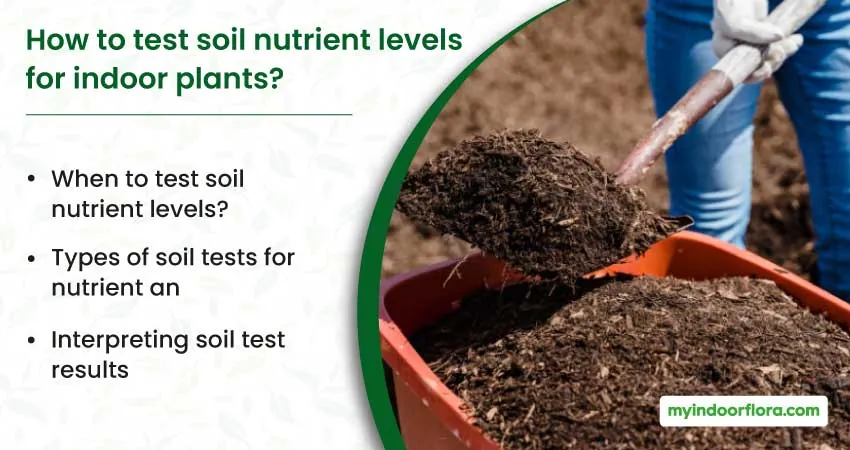
Regularly testing soil nutrient levels helps you identify imbalances and make necessary adjustments. Knowing when to test and choosing the right method are important for accurate results.
When to test soil nutrient levels?
It’s recommended to test soil nutrient levels before planting and at least once a year thereafter. Additionally, if you notice signs of nutrient deficiency or poor plant health, it’s a good idea to conduct a test.
Types of soil tests for nutrient analysis
There are two main ways to test soil nutrient levels: home soil test kits and professional soil testing services.
Home soil test kits
These kits are affordable, user-friendly, and readily available at garden centers or online. They typically include chemical reagents and color charts to help you analyze the nutrient content and pH of your soil. However, home test kits may not be as accurate or comprehensive as professional testing services.
Professional soil testing services
For more accurate and detailed results, consider using a professional soil testing service. These services often provide a thorough analysis of nutrient levels, pH, and other essential factors affecting plant growth. Many universities and agricultural extension offices offer soil testing services at a reasonable cost.
Interpreting soil test results
Soil test results usually provide recommendations on how to adjust nutrient levels and pH based on your plants’ needs. However, it’s essential to understand the specific requirements of the plants you’re growing, as different species may have unique nutrient preferences.
Now that we’ve covered soil testing let’s discuss how to adjust soil pH to optimize nutrient availability.
How to adjust the soil pH to promote nutrient availability?
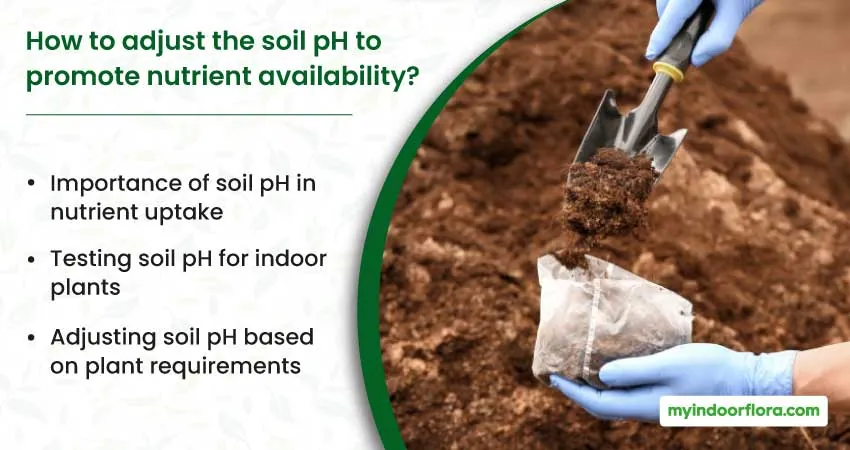
Soil pH plays a crucial role in nutrient uptake, as it influences the solubility of nutrients in the soil. Ensuring the right pH level for your indoor plants can significantly improve their overall health and growth.
Importance of soil pH in nutrient uptake
Most indoor plants prefer a slightly acidic to neutral soil pH, ranging from 6.0 to 7.0. However, certain plants like azaleas and blueberries require more acidic soil conditions. When soil pH is outside the optimal range for a specific plant, nutrients may become less available, leading to deficiencies or toxicities.
Testing soil pH for indoor plants
You can use a home soil test kit or a digital pH meter to test soil pH. It’s essential to test soil pH at the same time as nutrient levels to get a comprehensive understanding of your soil’s condition.
Adjusting soil pH based on plant requirements
Depending on your plants’ preferences, you may need to adjust the soil pH to create the ideal environment for nutrient uptake.
Lowering soil pH (acidifying)
To lower soil pH, you can use materials like elemental sulfur, aluminum sulfate, or sphagnum peat moss. When using elemental sulfur, be sure to follow the recommended application rates and mix it thoroughly into the soil.
Raising soil pH (alkalizing)
To raise soil pH, you can use materials like lime (calcium carbonate) or dolomitic limestone (contains both calcium and magnesium). Apply the recommended amount and mix it well into the soil. It may take several weeks to see the full effect of these adjustments.
Now that we’ve discussed soil pH adjustments, let’s explore ways to address nutrient deficiencies in indoor plants.
How to address nutrient deficiencies in indoor plants?
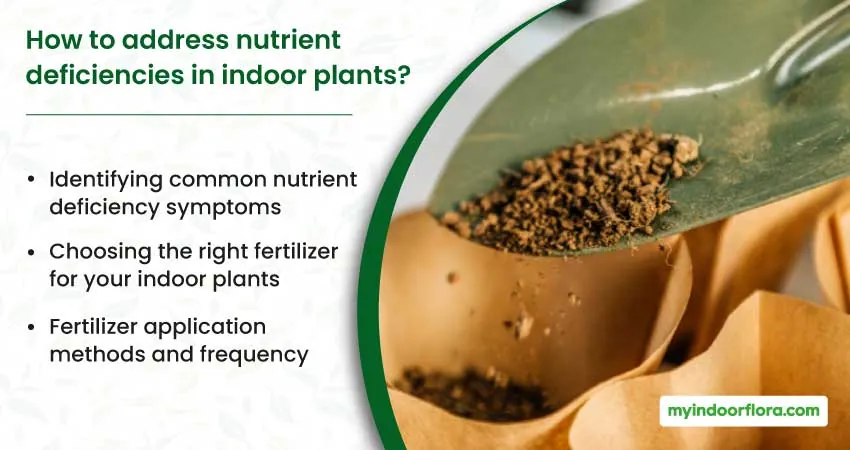
Identifying and addressing nutrient deficiencies is essential for maintaining healthy indoor plants. Choosing the right fertilizer and applying it correctly can significantly improve plant growth and development.
Identifying common nutrient deficiency symptoms
Plants exhibit specific symptoms when they lack certain nutrients. For example, nitrogen deficiency may cause yellowing of older leaves, while phosphorus deficiency can result in stunted growth and purple leaves. Familiarizing yourself with these symptoms can help you diagnose and address nutrient deficiencies more effectively.
Choosing the right fertilizer for your indoor plants
Selecting an appropriate fertilizer for your indoor plants involves considering factors such as the type of fertilizer, N-P-K ratio, and your plants’ specific needs.
Organic vs. synthetic fertilizers
Organic fertilizers, derived from natural sources like compost, manure, or bone meal, release nutrients slowly and improve soil structure. Synthetic fertilizers, on the other hand, provide nutrients more quickly but may not improve soil health in the long run.
Selecting the appropriate N-P-K ratio
Fertilizers are labeled with an N-P-K ratio, which indicates the percentage of nitrogen (N), phosphorus (P), and potassium (K) they contain. Choose a fertilizer with an N-P-K ratio that matches your plants’ nutrient requirements based on the soil test results.
Fertilizer application methods and frequency
There are various methods for applying fertilizer, including top-dressing, side-dressing, and liquid feeding. The frequency of fertilizer application depends on the type of fertilizer, the specific needs of your plants, and the growth stage. It’s essential to follow the manufacturer’s recommendations and avoid over-fertilization.
Can over-fertilization harm indoor plants?
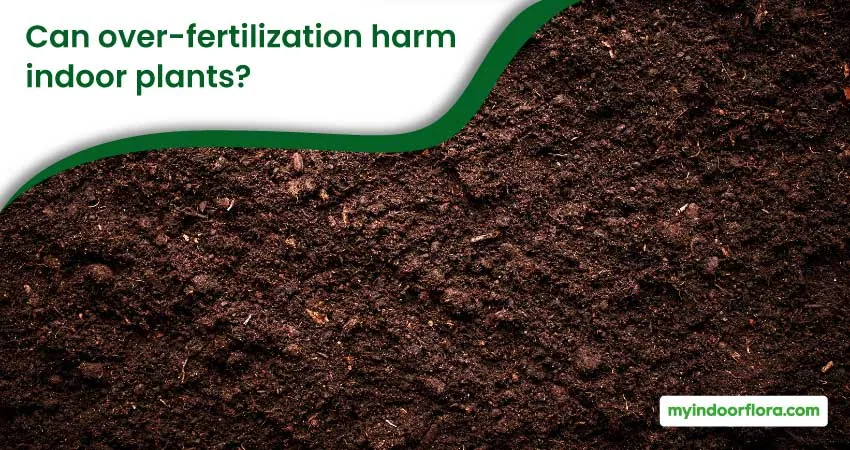
Yes, over-fertilization can be detrimental to your indoor plants. It’s crucial to recognize the signs of nutrient toxicity and take corrective measures.
Recognizing the signs of nutrient toxicity
Nutrient toxicity often manifests as leaf burn or tip burn, stunted growth, and reduced flowering. In severe cases, it can lead to root damage and plant death.
How to correct over-fertilization issues
If you suspect over-fertilization, you can take several steps to mitigate the issue:
- Remove any visible fertilizer residue from the soil surface.
- Flush the soil with water to help leach out excess nutrients.
- Allow the plant to recover before reapplying fertilizer at a reduced rate.
How to maintain optimal nutrient levels for indoor plants?
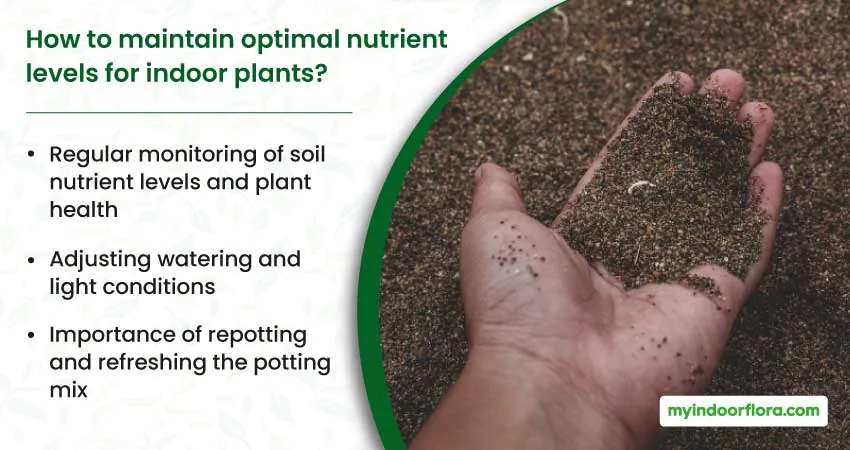
Regular monitoring and maintenance are essential for ensuring optimal nutrient levels and plant health. By adjusting watering and light conditions, repotting, and refreshing the potting mix, you can create the ideal environment for your indoor plants to thrive.
Regular monitoring of soil nutrient levels and plant health
Keep an eye on your plants’ appearance and growth, and test the soil nutrient levels periodically to identify any imbalances or deficiencies. This proactive approach will allow you to make timely adjustments and maintain overall plant health.
Adjusting watering and light conditions
Proper watering and lighting are vital for nutrient uptake and plant health. Overwatering can cause nutrient leaching, while underwatering can limit nutrient availability. Similarly, inadequate light may reduce the plant’s ability to utilize nutrients effectively. Adjust your watering and lighting practices based on your plants’ specific needs and the environmental conditions.
Importance of repotting and refreshing the potting mix
Over time, potting mixes can become depleted of nutrients and may require replacement or amendment. Regularly repotting your plants and refreshing the potting mix can help maintain optimal nutrient levels and support healthy plant growth.
Conclusion
Testing and adjusting soil nutrient levels for indoor plants is an essential aspect of maintaining a thriving indoor garden. By understanding the key nutrients, testing soil regularly, adjusting pH and nutrient levels, and addressing deficiencies, you can ensure your indoor plants have the necessary elements to grow and flourish. By being proactive and attentive to your plants’ needs, you’ll reap the benefits of a beautiful, healthy indoor garden.
